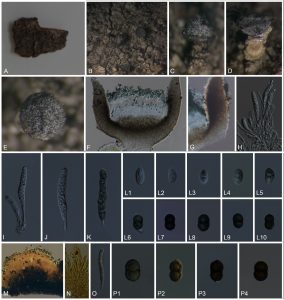Acolium yunnanensis Thiyagaraja & K.D. Hyde, sp. nov.
Index Fungorum number: IF557875;
Etymology – The specific epithet ‘yunnanensis’ was given after the place, where the fungus was collected.
Holotype – MFLU 19-0725
Thallus crustose, corticolous, epiphloedal, corticated and well-developed, surface pale gray. Prothallus indistinct. Photobiont present. Asexual morph: Undetermined. Sexual morph: Ascomata apothecial, 450–850 μm diam., 110–190 μm high, stipitate, mazaedioid, disc black, short cylindrical with whitish pruina on the upper and outer surface of the edge of the exciple. Exciple blackish brown, 65–105 μm thick laterally and 110–120 μm thick at the basal, carbonized. Hypothecium 40–70 μm thick, pale brown. Hymenium 40–70 µm thick, hyaline, not inspersed. Paraphyses 1–2 μm wide, branched, easily separable, irregularly branched. Asci 20–55 × 3.5–4.5 μm (x̄ = 37.5 × 4 μm, n = 40), 8-spored, cylindrical, with uniseriately arranged ascospores. Ascospores 8–12 × 5–7 μm (x̄ = 10 × 6 μm, n = 40), ellipsoidal to broadly ellipsoid, greenish to dark brown, hyaline when immature, 1-septate, thick-walled, constricted at the middle, distinctive ornamentation of longitudinally arranged ridges and irregular cracks, guttulate and verrucose, sometimes appendages present in the both ends, ejected ascospore masses lying on the thallus surface.
Material examined – China, Yunnan Province, Shangri La, N 27o 55′ 54.9”, E 099o 34′ 39.0”, 4045 m elevation, on living bark of unidentified plant, 12 September 2018, Vinodhini Thiyagaraja (Holotype MFLU 19-0725).
Chemistry – Thallus, Ascomatal gel I-, K-, Asci I-, K-
GenBank submissions – ITS: MW018873, β-TUB: MW116835, LSU: MW018872.
Known distribution (based on molecular data) – China.
Notes – Acolium yunnanense is phylogenetically closely related to A. inquinans (Fig. 26). However, the new isolate is distinct in the multi-gene phylogeny of combined mtSSU, ITS and β-TUB and morphology with the extant species of Acolium. The new species differs in the ascospore morphology and size of exciple in comparison to A. inquinans. Greenish ascospores sometimes have small appendages at both ends, guttulate in each locus, and a small exciple (5–105 μm thick laterally and 110–120 μm thick at the base) were observed in A. yunnanense in contrast to the dark brown ascospores without appendages and the absence of guttules and a larger exciple (125–160 µm thick laterally and, 290–380 µm thick at the base) in A. inquinans (Singh & Singh 2014). Acolium yunnanense reveals more than 2 % base pair differences in the ITS gene region in comparison to A. karelicum (MP56, 2001 Tibell UPS) and A. inquinans (O-L-186246, O-L-200169). Some strains (W17) lack complete sequence data in the GenBank. A lichenized species A. chloroconium is distinct from A. yunnanense in having smaller apothecia (up to 600 μm) and a yellow streak on the margin of the disk (Weber 1967). Acolium sessile and A. marcianum differ in their lichenicolous habitat, whereas A. yunnanense has a lichenized lifestyle (Prieto & Wedin 2017).

Acolium yunnanensis (D3S10, holotype). A–D, M Ascomata on substrate. E, F Vertical section through ascoma. G Vertical section through exciple. H, N Paraphyses. I–K, O Asci. L1–L10, P1–P4 Ascospores. M, N, O, P1–P4 Ascospores stained with lugol’s solution. Scale bars: C = 200 μm, D = 100 μm, E–F = 200 μm, G–K, O = 20 μm, L1–L10, P1–P4 = 10 μm.
